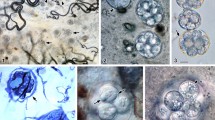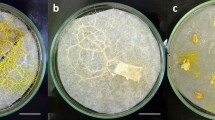Abstract
The mode of hyphal interaction and parasitism ofPythium spp. andRhizoctonia solani byTrichoderma hamatum was studied by both phase-contrast and Nomarski differential interference-contrast microscopy. Directed growth of the mycoparasite toward its host was observed. In the area of interaction,T. hamatum produced appressorial-like structures attached to the host cell wall. Subsequently, several different types of interactions occurred.T. hamatum either grew parallel to and along the host hypha or coiled around its host. In the contrast regions the parasite formed bulbular or hook-like structures that contained granular cytoplasm. In other cases the parasite penetrated into and grew within the mycelium ofR. solani orP. ultimum. As a consequence of the attack, the host hypha became vacuolated, shrank, collapsed, and finally disintegrated. These observations suggest the involvement of parasitism followed by lysis rather than involvement of antibiotics in this host-mycoparasite relationship.
Similar content being viewed by others
References
Backman. P. A., and R. Rodrigues-Kabana: A system for the growth and delivery of biological control agents to the soil. Phytopathology65, 819–821 (1975)
Chet, I., and R. Baker: Induction of suppressiveness toRhizoctonia solani in soil. Phytopathology70: 994–998 (1980)
Chet, I. and R. Baker: Isolation ofTrichoderma hamatum from soil. naturally suppressive toRhizoctonia solani and its application as a biocontrol agent. Phytopathology (in press)
Chet, I., S. Fogel. and R. Mitchell: Chemical detection of microbial prey by predator. J Bacteriol106, 863–867 (1971)
Dennis, C., and J. Webster: Antagonistic properties of species-groups ofTrichoderma. I. Production of nonvolatile antibiotics. Trans. Br. Mycol. Soc.57, 25–39 (1971)
Dennis, C., and J. Webster: Antagonistic properties of species-groups ofTrichoderma. II. Production of volatile antibiotics. Trans. Br. Mycol. Soc.57, 41–48 (1971)
Dennis, C., and J. Webster: Antagonistic properties of species-groups ofTrichoderma. III. Hyphal interaction. Trans. Br. Mycol. Soc.57, 363–369 (1971)
Elad, Y., I. Chet, and J. Katan:Trichoderma harzianum: A biocontrol agent ofSclerotium rolfssi andRhizoctonia solani, Phytopathology70: 119–121 (1980)
Hadar, Y., I. Chet, and Y. Henis: Biological control ofRhizoctonia solani damping-off with wheat bran culture ofTrichoderma harzianum. Phytopathology69, 64–68 (1978)
Harman, G. E., I. Chet, and R. Baker: Seed treatment withTrichoderma hamatum as a means of preventing seed and seedling disease induced byPythium spp. orRhizoctonia solani. Phytopathology (in press)
Hoch, H. C., and M. S. Fuller: Mycoparasitic relationship. Morphological features of interactions betweenPythium acanthicum and several fungal hosts. Arch. Microbiol.111, 207–224 (1977)
Jansson, H. B., and B. Norbring-Hertz: Attraction of nematode to living mycelium of nematophagous fungi. J. Gen. Microbiol.112, 89–93 (1979)
Jones, D., and D. Watson: Parasitism and lysis by soil fungi ofSclerotinia sclerotiorum (Lib) DeBary, a phytopathogenic fungus. Nature224, 281–288 (1969)
Jordan, E. G., and H. L. Barnett: Nutrition and parasitism ofMelanospora zamiae. Mycologia70, 306–312 (1978)
Liu, S., and R. Baker: Mechanism of biological control in soil suppressive toRhizoctonia solani. Phytopathology (in press)
Toyama, N., and K. Ogawa: Purification and properties ofTrichoderma viride mycolytic enzymes. J. Ferment. Technol.46, 626–633 (1968)
Wells, H. C., K. K. Bell, and C. A. Jawarsky: Efficacy ofTrichoderma harzianum as a biological control forSclerotium rolfsii. Phytopathology62, 442–447 (1972)
Author information
Authors and Affiliations
Rights and permissions
About this article
Cite this article
Chet, I., Harman, G.E. & Baker, R. Trichoderma hamatum: Its hyphal interactions withRhizoctonia solani andPythium spp.. Microb Ecol 7, 29–38 (1981). https://doi.org/10.1007/BF02010476
Issue Date:
DOI: https://doi.org/10.1007/BF02010476




